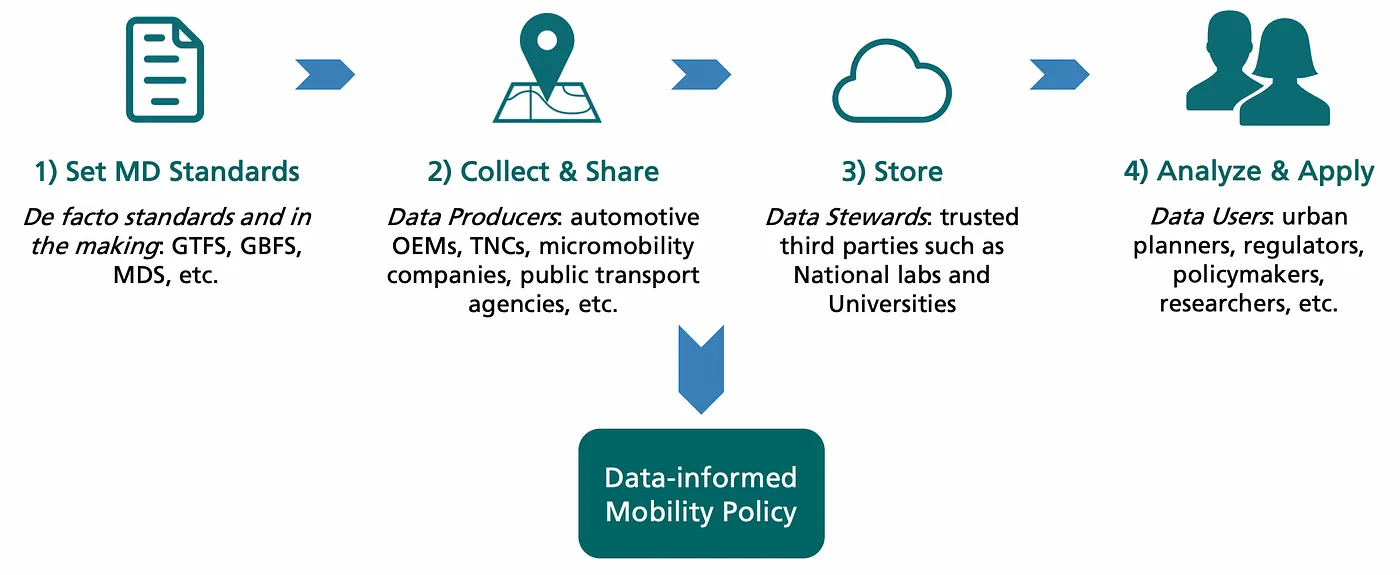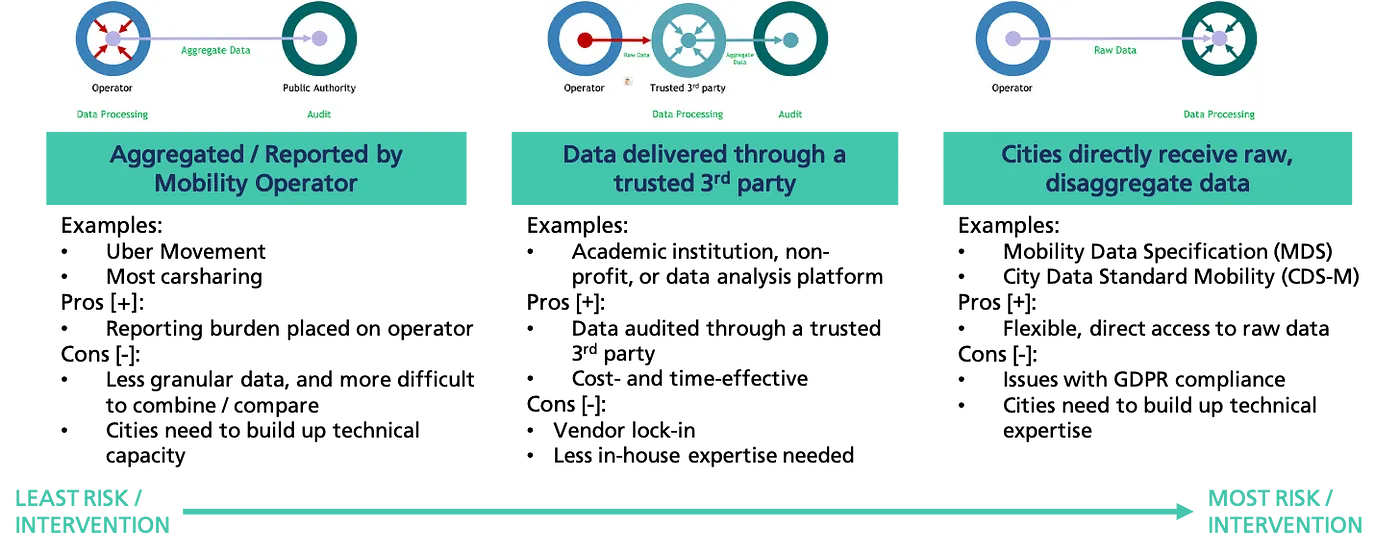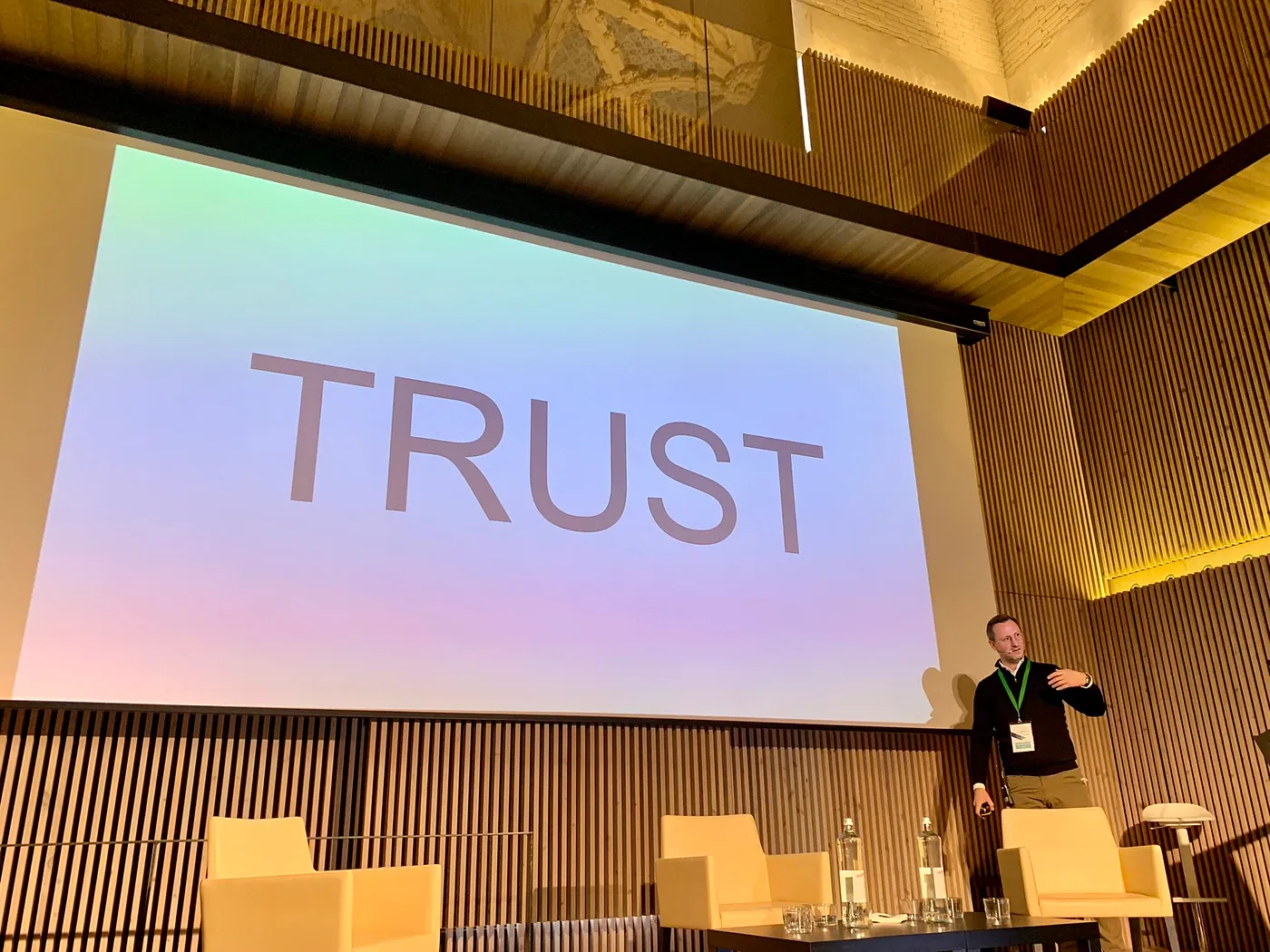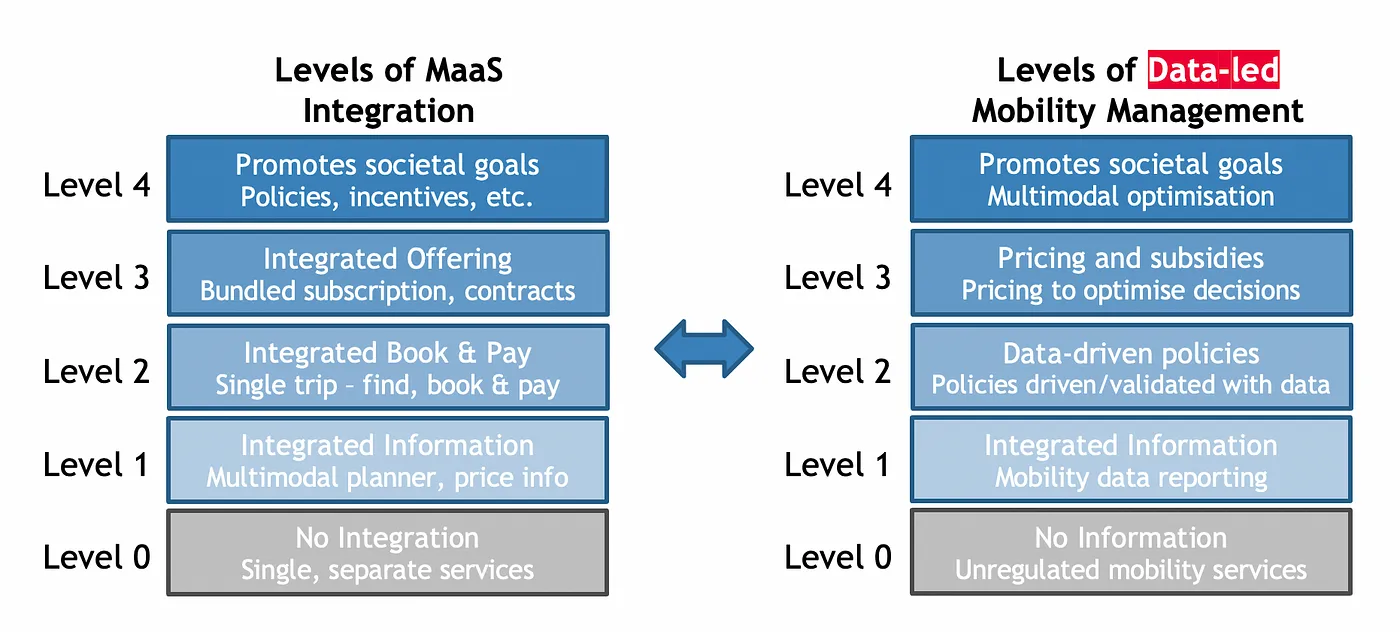Author: Josep Laborda (Factual)
Data is ubiquitous. Without being quite conscious, we all generate vast amounts of data when moving from A to B, whether by car, bike, walking, using public transport, or other not-so-new mobility services. These mobility data have huge potential which remains mostly untapped today. Data empower cities to make informed decisions in terms of mobility planning and management. For this reason, data sharing between cities and mobility providers -incumbents and new entrants- is of strategic importance. Data protection and privacy are nevertheless key issues in this context. Dependent on mutual trust, different models for mobility data sharing are feasible in the collaboration between cities and mobility providers. There is no clear best practice, as each case must be assessed individually. Only with the contribution of data provided by as many as the players involved possible, Mobility as a Service (MaaS) at its highest levels of integration will succeed, otherwise we will remain at level 1 with route planners kind of influencing the way people move. MaaS aims to maximise public benefit, strengthen public transport, and meaningfully integrate private mobility services. Mobility providers and cities are mutually dependent on each other for long-term, sustainable success that also brings social and environmental benefits, where cooperation and incentive schemes will be key to success.
“Data is the new oil” is a tired mantra for the modern times. While huge value can be unlocked by ensuring access to curated data turned into actionable insights that mobility managers can leverage, do not forget the old but prevailing rule rubbish in = rubbish out. Scattered, low quality mobility datasets offered under not-so-open data portals are no oil to move anything, particularly if one would associate the idea of oilto some sort of monetary value. Moreover, in times when decarbonisation is top in the agenda of mobility leaders, data as oil is a deprecated metaphor. Oil is oldish. Words matter.
Getting around the city using new mobility services is becoming commonplace. In just a few taps on an app users can today get access to a wealth of ready-to-use vehicles just around the corner.
Conveniently. Swiftly. Fun.
As users locate, book, pay for, and ride a shared vehicle they produce loads of data. And so they do when they use public transport. Indeed, public transport authorities, operators, and cities worldwide have become open data pioneers by widely adopting de facto data standards and leveraging them to implement data-driven mobility strategies. Unfortunately, though, mobility data is still too often kept in silos, hindering its potential for gleaning deeper, actionable insights. New (and not so new) private mobility operators are generally more reluctant to open their data, if not forced to, or if the right incentives are not available (such as mutually beneficial Public-Private Partnership models towards the realisation of MaaS). For cities, access to data from mobility operators providing their services in the public right of way is a priceless tool for enabling more informed mobility planning and management. For mobility operators it can provide valuable information to enhance their competitiveness and improve the efficiency of their operations.
Several hurdles must be overcome for mobility data to unlock its (huge) expected value: the lack of trust between the different players in the highly competitive urban mobility market, the need for standards enabling interoperability, and a level playing field setting the legal, regulatory, and technical conditions for effective, secure, and fair data sharing.
Data as a game-changer for urban mobility
New mobility services continue to evolve and change the urban mobility landscape. This is especially true for micromobility. Micromobility refers to a range of transportation modes for short distance travel using light vehicles that are typically used by one person (e.g., bicycles and scooters). Today, these are often electric vehicles that are part of a self-service system and are rented by people for short-term use within a city. Given this, it is critical, and strategic, to leverage new mobility data to evaluate and understand how new mobility services are reshaping our communities on everything from equity, inclusiveness, road safety, and the environment (aka sustainable mobility).
Because cities did not act quickly enough to set data sharing frameworks when ride-hailing companies burst into the mobility market a decade ago, and with new shared mobility services still in their beginnings (or in their infancy, if we refer to micromobility), cities now have the not-to-be-missed opportunity to avoid repeating the same mistakes and so require the data they need that will better inform their decision-making as regards mobility planning and management.
To do so, cities will need to set clear, indisputable data sharing requirements to mobility operators that identify what information they are seeking to acquire, how it will be collected, processed, shared, and stored, the quality, accuracy, format (that is, standards), and frequency of the requested data, as well as determine clear privacy guidelines to protect both the end users, but also the legitimate concerns from mobility operators on commercially sensitive data.

It is worth underlining the fact that the definition of personally identifiable information (PII) is rapidly changing and varies considerably from jurisdiction to jurisdiction, so it will be important for cities to be clear about what they are to consider PII and how best to manage and protect those data, where GDPR has laid out a specific set of regulations that deal with PII.
Besides separate data sharing agreements with mobility providers, there are other innovative and promising ways cities can obtain coveted data. The recently started “Cleanergy 4 Micromobility” project, coordinated by Factual and co-funded by the EIT Urban Mobility, addresses this very specific aspect. The goal of the project is to develop an e-scooter docking station. These are designed to address the main problems of e-scooters and ensure an orderly, safe, and sustainable micromobility growth. The docking stations will make e-scooter parking more organised and secure. They will also incorporate storage space for helmet provision and solar power generation so that e-scooters can be charged with green energy directly on site. But the most crucial and game-changing aspect is data management. This is because the docks in which the shared e-scooters must be parked will belong to the city council. Hence, this model will lead to valuable information about the usage of shared e-scooters, as the city council will automatically have access to all the mobility data generated by each e-scooter that starts a trip from any dock to another.
Trust architecture models for mobility data sharing
In mobility, one size does not fit all. Any framework for mobility data sharing implies that mobility operators and public authorities must cooperate and establish some level of trust with each other, where trust is linked to transparency on purpose, use and data minimisation principles. We basically differentiate three schemes, where it is ultimately up to the cities to define which model suits them best.
Mobility operators can provide the requested data to the city’s governing agency directly, and this can be done basically in two radically different ways, carrying different implications:
- When operators do not trust public authorities or are reluctant to share their data because they feel their users’ privacy, or their competitive advantage might be compromised, they “cook” data first by aggregating them, and only then they provide a subset of data to public authorities, which might use them for auditing purposes. This is the case, for example of Uber Movement, where the company releases datasets to the public in support of urban and transportation planning. To prevent user privacy issues, Uber aggregates car GPS traces into small areas and releases free data products that indicate the average travel times of Uber cars between them. Although this is certainly somewhat useful, some might as well consider it rather a PR strategy, where some researchers have even pointed out the extent to which such data is actually helpful at all to support or inform any mobility strategy. Overall, it is quite evident that Uber and other mobility operators are generally rather reluctant to share raw data with public authorities, which is the next scheme we analyse, where…
- … Cities do not trust operators, and so they mandate that operators send all the raw data they generate while operating their services. A remarkable initiative designed to govern data sharing from shared micromobility service providers to cities is the Mobility Data Specification (MDS), “a digital tool that helps cities to better manage transportation in the public right of way. MDS standardises communication and data-sharing between cities and private (micro)mobility providers, such as e-scooter and bike share companies. This allows cities to share and validate policy digitally, enabling vehicle management and better outcomes for residents. Plus, it provides mobility service providers with a framework they can re-use in new markets, allowing for seamless collaboration that saves time and money”. The MDS has gained a lot of attention from cities and the micromobility industry since it was introduced by the Los Angeles Department of Transportation (LADOT) in September 2018. It builds on the GBFS standard (General Bikeshare Feed Specification) by expanding on what additional data cities could require from mobility operators. Unlike the GBFS, in addition to the status of available vehicles the MDS also specifies how information should be shared about vehicles that are unavailable due to redistribution, maintenance, or low battery through vehicle event status changes. The MDS has also introduced the concept of sharing data for trips, including starts, ends, and entire “breadcrumb” trip trajectories. While the MDS was initially designed for dockless bikes and scooters, and currently only specifies how data from these services should be shared, many cities hope to expand these data sharing standards to other services, such as ridesharing. The MDS is not without controversy: concerns have been early raised by major players in the market, such as Uber, which have sued LADOT over what the company considers too stringent data-sharing requirements. This is only one reason why the MDS is being examined by some EU countries to assess compliance with the GDPR, where the TOMP working group is working on the alternative City Data Standard for Mobility (CDS-M) API. The TOMP-WG (Transport Operator, MaaS Provider — Working Group) is “a collaborative initiative to create a standardized language for the technical communication between Transport Operators and MaaS Providers within the MaaS ecosystem by means of an API”.
- A compromise solution is that where all parties trust a 3rd party that handles all data. Such party can be an academic institution, a non-profit, a public authority, or a data analysis platform, such as Fluctuo, Vianova, Populus, or Remix, to name a few. This is usually a cost- and time-effective option for cities that do not have the required data science expertise, but could eventually lead to some sort of vendor lock-in. The much talked-about recent acquisition of Remix by Via, a Demand-Responsive Transport (DRT) service provider, for $100 million is only one example how valuable data is for transportation planning. Mobility operators (like Via) can then leverage such data to provide evidence to cities on the convenience of incorporating their services. Also remarkably, Factual joined forces with several other stakeholders under the “MultiDEPART” project, co-funded by the EIT Urban Mobility, to develop a dashboard and tools for cities to plan, manage, and monitor vendor-agnostic DRT solutions.
So, of the three described approaches to mobility data sharing, the decision which one to pursue ultimately basically comes down to how much risk, and how much active intervention, in terms of data processing and analysis, cities are willing, or are prepared to take. The price tag (to be) associated to mobility data remains one of the most complex issues to address.


Acknowledging that an effective trust environment is critical for any modern mobility ecosystem to thrive, with different players coopeting in some sort of fragile equilibrium but quite often also struggling to gain any competitive advantage, Factual coordinates Molière -short for MObiLIty sERvices Enhanced by Galileo & Blockchain- a Horizon 2020 project co-funded by the EUSPA. Molière has the bold mission of building the world’s best open data commons for mobility services, the so-called “Wikipedia of public transport and new mobility data”, a Mobility Data Marketplace (MDM) developed by Iomob underpinned by blockchain technology, where decentralisation will provide digital trust, transparency, and automatisms in the way mobility data is stored, processed, and used for good. The project will also raise the profile, visibility, availability, and utility of geolocation data (of end users and the vehicles they use) provided by Galileo, among other satellite constellations. In its piloting phase in 2022, Molière will demonstrate how the concepts developed in the project can be applied to high added value use cases, such as to incentivise travellers to use micromobility as a convenient transportation option for trips starting in “transit deserts”, and upgrading an electric car-sharing fleet with state-of-the-art Galileo-enabled On-Board Units to enable more efficient fleet management.
Data makes MaaS happen
Data is of utmost importance to sustain effective MaaS that maximises public benefit and increases public transport ridership while establishing a level playing field for privately held mobility services to thrive. Analogous to the widely referenced four levels of MaaS integration topology, four levels of Mobility Management are presented, highlighting the key contribution of mobility data in each level.

- In recent years, many cities have implemented different sorts of Level 1data-led mobility management by mandating access to mobility datasets from private mobility operators, basically to oversee their operation in the public right of way. Typically, data is required as a pre-requisite to be granted a license to operate, and such information is basically used to monitor very elementary adherence to city ordinances. SMOU is a remarkable example how a city-led mobility app has incorporated all the information on the available offer of bike-, moped-, and car-sharing in the city of Barcelona.
- Level 2 is achieved when cities are able to leverage the data they receive from mobility operators to make more informed decisions and set more effective mobility policies, contributing to alleviating transport externalities, such as congestion and climate impacts, and addressing equity goals. Examples of data-driven policies that might be implemented by cities to manage mobility fleets include:
Parking: definition of geospatial areas (geofencing) for preferred and/or restricted parking to protect pedestrian safety or other needs
Trips: definition of routes, or lanes, where micromobility or other types of vehicles have priority over other road users.
Equity: cities might require or subsidise (see Level 3) fleet services in an area that is underserved by other means of transport, or where specific micro-incentives are put in place where, for instance, first/last mile trips using micromobility services are subsidised if and only these trips connect users to public transport hubs (here, continuity of data under a MaaS scheme is needed, so that the policy maker can verify that incentivised trips actually feed public transport, for instance)
Fleet size: cities might want to set a minimum level of service or maximum fleet size per each allowed service area
A practical example for Level 2 of data-led mobility management, which also includes some aspects of the just mentioned data-driven policies, is the pioneering “RideSafeUM” project. In this EIT Urban Mobility co-funded project, Factual will cooperate with micromobility industry leader Dott and other stakeholders to develop an advanced safety solution for micromobility vehicles. The increasing use of micromobility has led to safety concerns for both drivers and pedestrians. Within the project a generic and versatile solution is developed, enabling data-driven decision making. Thus, data from mobility operators can be used to define more effective mobility policies. Using various technologies such as computer vision software, cameras, geolocation data, and gyro sensors, users are alerted via a front-end app when rules are violated (e.g., exceeding the allowed speed limit or driving on the sidewalk), and in case of an accident, an emergency alert is automatically sent to a central control system. The developed system will thus help to better enforce regulations and prevent accidents. Factual will focus on creating a geofencing layer that will allow the city to be classified into different zones with different regulations. In an associated dashboard, the data collected by the user software will be analysed and visualised in order to identify issues more easily. Based on the dashboard and the information collected, the city will be able to make data-driven decisions and policies on how and where to improve its urban infrastructure. This will result in increased safety for pedestrians and road users.
Factual also takes part in the Horizon 2020 project nuMIDAS, where new and emerging mobility trends are analysed with a focus on reviewing and assessing a range of options for collecting and using new mobility data, by means of new data collection and management approaches, including new methods and tools to exploit these data, encompassing also Artificial Intelligence / Machine Learning techniques for dealing with Big Data.
Given that most traveller decisions are largely influenced by time and cost, pricing is an incredibly important tool for public agencies to leverage in shaping desired transportation outcomes.
- Level 3 mobility management is achieved when cities effectively leverage pricing strategies, including subsidies, to influence how travellers decide whether to walk, drive, use public transport, shared mobility services, or hail a ride.
Many cities overseeing shared micromobility programs have begun to implement more complex policies for pricing the public right-of-way, including parking fees (applied to restricted parking areas), fines for non-compliance with equity policies, and fees for riding in unauthorised zones.
While setting a fair price for access to roads, kerbs, and on/off-street parking is an important mechanism for cities to influence traveller behaviour, also important are subsidies. Public transportation services are typically heavily subsidised because they are viewed as providing a significant public utility — in short, public transport enables cities to move more people more efficiently than would otherwise be possible if they all drove individual vehicles.
Similarly, as new private mobility services continue to expand, it is important for cities to determine when and where private mobility services provide social benefit to consider subsidising them.
It goes without saying that public subsidies must be implemented in the most transparent, cost-efficient, targeted way, and be designed to address Key Performance Indicators included in cities’ mobility plans.
Related to the above, Rideal is a versatile Software as a Service (SaaS) platform that Factual’s Venture Builder, Keita Mobility Factory, has developed that can be plugged in to any existing MaaS or mobility operator backend platform and be used to design and manage micro-incentive programmes to nudge behavioural change towards more sustainable mobility and monitor its effectiveness in real-time.
Subsidising shared mobility with public money is not new. For example, prior to the emergence of venture-backed electric scooter companies, the majority of bikeshare systems received public subsidies. Moreover, important industry stakeholders, such as the UITP, or POLIS, to name some, are embracing the idea of micro-incentives to any mobility service available in a city as a way to implement more efficient mobility strategies, where availability of data provided by / shared through MaaS platforms is critical.
Key examples of when cities may wish to provide incentives to private mobility operators include:
– Supporting first/last-mile access to mass transit, for instance by incentivising micromobility services
– Expanding transportation access in underserved areas, for instance by incentivising ride-hailing or DRT
– Shifting travellers to certain modes, and in certain time frames, to reduce congestion during peak transit times, flattening demand curves
– Supporting (incentivising) mobility services that have a lower carbon footprint than personal vehicles
Today, many cities have realised Level 1, 2, and perhaps 3 of mobility management, though micro-incentives are still a nascent idea which Factual is proposing through Rideal.
Third party mobility data analytics platforms deliver Levels 1 to 3 mobility management solutions for cities to manage multiple shared mobility services, including shared bikes, scooters, mopeds, and cars, but few cities have implemented mobility management beyond micromobility, and cities are struggling to effectively implement mobility management policies to optimise across the multiple transportation modes, other than micromobility.
- With Level 4 mobility management, public agencies will be able to influence how travellers make transportation decisions across modes to promote societal goals: reducing transportation climate impacts, alleviating congestion, and expanding equitable access to mobility. To reach Level 4 mobility management, cities will need access to data from the various transportation services delivered on their public right-of-way to make data driven decisions, including the implementation of pricing and incentives. Level 4 mobility management can more easily be achieved alongside Level 4 MaaS solutions. That is, the mechanism through which real-time information about transportation options, and specifically new pricing and subsidies, could be more easily delivered to a large population of travellers through one, or more likely, multiple, MaaS consumer-facing applications.
Mobility data sharing will not just happen overnight. A forward-looking level playing field that does not undermine innovation and competitiveness from new mobility operators must be used as a lever for it to happen. The price tag to be put on mobility data remains an unknown, where the value of such data is an even more abstract related concept. And one that is much more interesting than fluctuating oil prices.
About Factual
Factual is a boutique innovation consultancy committed to transforming mobility. Our secret sauce is a combination of strategic foresight, international cooperation through Research & Development projects, and in-house incubation of new, disruptive mobility concepts. Our team is composed of experienced professionals with a passion for mobility and a unique blend of technical background and business acumen. We strive to generate long-lasting impact by fulfilling our customers’ expectations and always steer towards exceeding them. Meeting a customer’s goal is not a finish line for Factual: we’re always planning for the next frontier, identifying a new revenue stream, working to leverage an unmet opportunity, anticipating the future.




